





The trichlorine tablets or slow dissolving chlorine tablets contain 90% of the useful chlorine so they allow a continuous chlorination avoiding the loss of chlorine due to the effects of the sun. This allows a slower dosage and therefore greater effectiveness over longer periods.
We distinguish three types of chlorine for pool maintenance:
- in tablets: ideal for weekly pool water maintenance.
- granular: ideal for daily pool water maintenance
Chlorine tablets are a good idea for weekly pool water maintenance to keep the water clean and disinfected. Slow dissolving chlorine tablets offer an extended duration for 6-7 days, the duration will depend on the hours of operation, water flow, temperature, among other factors.
PLEASE NOTE: In pools made of liner, polyester, vinyl or painted, it should not come into direct contact, as it may cause discoloration.
Chlorine tablets are used for weekly pool water maintenance. For a correct maintenance follow the next steps:
3. Leave the filtration equipment in operation
IMPORTANT: The initial treatment or shock treatment should be repeated whenever there is a lack of transparency in the pool water.
NOTE: add the product preferably at dusk and without the presence of bathers.
| Look | Solid in tablets of 200 g |
| Color | White |
| Chlorine content useful | 90 % |
| pH (1%) | 2 - 3 |
| Container | 5 Kg |
| Moisture | 0,30% |
| Solubility | 1.2 g/100 ml |
In order to estimate the right amount of chlorine to add to the pool, it is important to check the pH and chlorine levels. It is therefore important to test with a test strip at least 2-3 times a week and to regulate the parameters.
It is important to distinguish between free chlorine, residual chlorine and total chlorine.
Less than optimum chlorine will cause bacterial and algae growth resulting in unhygienic and unpleasant conditions. Dosages may vary depending on the number of bathers, sunlight, water temperature or weather conditions.
Receive it between tomorrow and Tue 1